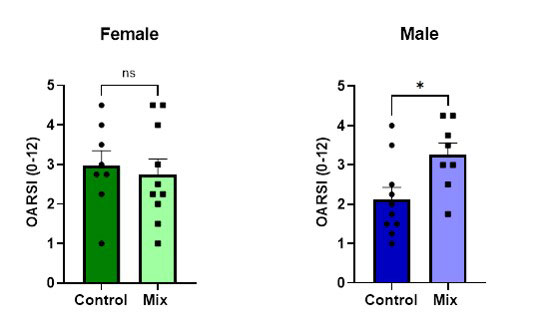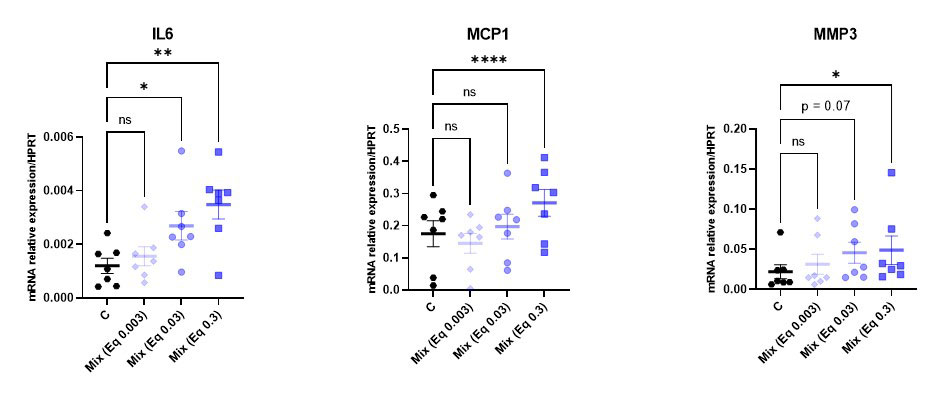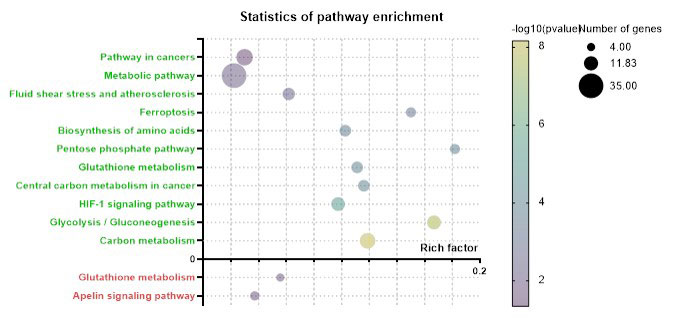Session Information
Session Type: Poster Session A
Session Time: 1:00PM-3:00PM
Background/Purpose: Humans are exposed to pollutants with endocrine disruptors (ED) properties from their in utero life. Among them, a mix of 15 pollutants (perfluorinated compounds, bisphenol A, phthalates …) ubiquitously present (i.e, amniotic fluid of pregnant women, blood sera) has been associated with thyroid disruption and for some of them with language delay acquisition in children of exposed women (1). Since pollutants exposure has been associated with an increased risk of joint diseases (2), we aimed to determine the effects of the pollutants mix on cartilage homeostasis and chondrocyte function.
Methods: Female C57/B6 mice were exposed to a mix of 15 pollutants in their drinking water (equivalent dose of perfluorooctanoic acid [PFOA] 0.1 µg/day) 15 days prior to mating and during gestation. The newborn mice of exposed mothers were also exposed to the same mix until their sacrifice at 10 months (n= 18). A parallel group of unexposed female mice and newborn mice served as controls (n=18). At sacrifice, knees were harvested and we analyzed histological analysis of cartilage degradation, synovium inflammation and subchondral bone areas (Bone area/Total area ratio). In vitro, primary culture of articular chondrocytes isolated from newborn C57/B6 mice (n=7) were exposed or not to different doses of the mix of pollutants for 24h. We evaluated cell toxicity by LDH, the expression of cytokines (interleukin [IL] -6) chemokines (MCP1) and metalloproteases (MMP-3) by RT-qPCR and ELISA. After 15 minutes of exposure, we also evaluated the MAPK38 phosphorylation by Western Blot. Finally, we determined the differentially expressed (DE) genes by whole genome RNA-sequencing between murine chondrocytes treated or not by 24 h of mix (eq PFOA 0.03 µg/mL) to identify pathways involved in cell activation.
Results: At 10 months, the mean OARSI score was higher in exposed male than in controlled male (3.25 + 0.31 vs 2.12 + 0.31 p=0.02), but not in female (Fig.1). There was no difference in mouse phenotype (height, weight, behavior), subchondral bone areas nor in synovitis. In vitro, the mix of pollutants did not induce a direct cell toxicity (LDH) while it increased the expression of inflammatory cytokines and metalloproteinases by qPCR [IL6 : + 222% (p< 0.05) ; MCP 1 : + 155% (p< 0.05) , MMP-3 : +222% (p< 0.05) for the mix at eq. PFOA 0.03 µg/mL] with a dose-effect (Fig. 2). Similar results were observed in ELISA. At 15 minutes, the mix (eq PFOA 0.03 µg/mL) significantly increased p38 MAPK phosphorylation. Among the 256 DE genes, 214 were upregulated and 42 downregulated in exposed chondrocytes. The gene ontology identified several pathways involved in oxidative stress such as glutathione metabolism, pentose phosphate pathway and ferroptosis (Fig. 3)
Conclusion: ED exposition induces early cartilage defects in mice that could be related to a local increased secretion of inflammatory cytokines and metalloproteinases by chondrocytes and to chondrocytic oxidative stress enhancement. Altogether, this study suggests that exposition to pollutants disturbs cartilage homeostasis, which can increase susceptibility to joint diseases.
To cite this abstract in AMA style:
Berkani S, Kouki I, Babajko S, Pigenet A, Natarajan p, Ordoukhanian P, Houard X, Lotz M, Demeneix B, Fini J, Berenbaum F, SELLAM J, Courties A. Exposure to Pollutants with Endocrine Disrupting Properties Is Associated with Early Cartilage Defects and Chondrocyte Inflammatory and Oxidative Activation [abstract]. Arthritis Rheumatol. 2022; 74 (suppl 9). https://acrabstracts.org/abstract/exposure-to-pollutants-with-endocrine-disrupting-properties-is-associated-with-early-cartilage-defects-and-chondrocyte-inflammatory-and-oxidative-activation/. Accessed .« Back to ACR Convergence 2022
ACR Meeting Abstracts - https://acrabstracts.org/abstract/exposure-to-pollutants-with-endocrine-disrupting-properties-is-associated-with-early-cartilage-defects-and-chondrocyte-inflammatory-and-oxidative-activation/



